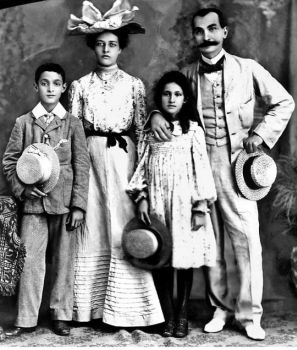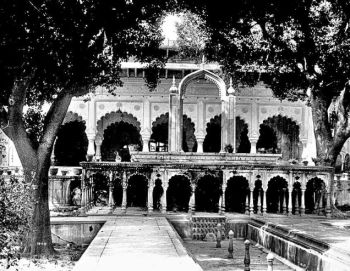Ranvir Shah, The Hindu Magazine, 28th December, 2010
Raja Deen Dayal’s photographs reveal his fine vision through the myriad subjects that fascinated him, making him an important presence in the visual history of India. An exhibition of his works opened at the IGNCA in New Delhi last week.

Raja Deen Dayal – The Studio Archives from the IGNCA collection, is a show that opened on Indira Gandhi’s birthday in a new gallery space at the IGNCA in Delhi. As one entered the premises large sepia blow-ups of Deen Dayal’s work were framed against old trees lit warmly on the campus. The cultural archives of the IGNCA in a significantly prescient move had acquired, in 1989, the collection of near 2900 glass plate negatives and other objects from the family of Raja Deen Dayal such as studio props, cameras, lenses and studio registers. There are 220 images from these negatives, which are digital reproductions of bromide silver photographs, which were produced after the selected images were cleaned and colour corrected to present them in a condition closest to the original, in a splendid exhibition curated by Dr.Jyotindra Jain and Pramod Kumar K.G.
Early days
Born into a Jain family of Sardhana, near Meerut, Deen Dayal rose from being a civil engineer at the Indore Public Works Department after completing his studies and spending sometime there as a head estimator and draftsman. When he began to take photographs, he came to the attention of the Maharaja of Indore, Tukoji Rao II and soon opened his studio there with commissions from the Maharaja and the British. Sir Lepel Griffin of the Bengal Civil Service commissioned him to do archaeological photographs and he created a portfolio of 86 photographs that were known as ‘Famous Monuments of Central India’. From 1885 he worked as a photographer at the court of the sixth Nizam of Hyderabad where he established a base and his family continued the studios after him with the seventh Nizam as well. Branches in Bombay and Indore were run by his sons as well and today in Hyderabad descendants continue to run the studio.
Dr. Jyotindra Jain, an authority on popular culture and well known for his setting up of the Crafts Museum in Delhi, says in his curator’s note: “One of the criteria kept in mind while selecting images for the exhibition was that each image reflected a certain degree of aesthetic, subjective, performative or ‘double entendre’ layering, evoking the Deen Dayal essence. Typical of Raja Deen Dayal’s ethos, which is reflected in his collective body of work, is that he was primarily a patron’s and a commissioner’s photographer whose aesthetic conceptualisations balanced between his fine photographic vision and the performative dispositions of his clients/subjects”.
The exhibition has been arranged in chronological and thematic loops starting with his work of early architectural wonders, then going to his time in Hyderabad and after that his commissions of royalty across India as well as studio portraits and ethnographic studies. The excellent exhibition design and accompanying catalogue done by the Vivek Sahni Studio are a great enhancer to the absorption of the visuals in one’s mind’s eye. At the entrance is a large blown up image of the fountains in front of Gopal Bhavan palace in Deeg Rajasthan. Here water bodies cooled the royalty in the summer months and pleasure pavilions were planned around that. In this image is the arch for a swing or “ hindola” believed to have belonged to Shah Jahan. The visual allows you with a blink of an eye to imagine princes and princess cavorting at dusk as cool breezes brought in the fragrances of the gardens at hand.
Pramod Kumar K.G. says in his curator’s comment: “Most of the photographs in this series show views of historical monuments with some sites photographed from two or more vantage positions. In Deen Dayal’s set manner of photographing monuments, these structures are seen in the middle of the frame against the clear sky, the foreground showing empty space or water. Most of these sites have changed dramatically over the years and some no longer exist.” In his times with the Nizam he not only photographed him but also his close friends, courtiers and those in the Zenana. An interesting photograph that reveals the openness and broadmindedness of one of the Nizam’s close confidantes is a family portrait of Sir Afzar Jung Bahadur, the ADC and commander of the Hyderabad army, along with his family. The painted backdrop and props indicate that it was taken at the Deen Dayal Studios, and unusually, for a Muslim nobleman’s family in the late nineteenth century, posed in western clothes. Visible here is the use of wax around the heads of the sitters to enhance the same in the print by increasing the contrast of the negative.
Part of the ceremony of the Raj besides the durbars and show of pomp and pageantry for visiting royalty and the British were the ‘Shikhars’ or hunts. What may be seen as politically incorrect now was par for the course and the ‘Shikhar’ photographs have many visuals of a relaxed camaraderie amongst the closer group of the Nizam with strict court hierarchy loosened in the camp. However one monumental and somewhat strange picture is of the Nizam with a tableaux of stretched carcass skins over a wall with the Nizam in the margins but a board proclaiming him as ‘The Royal Champion Crackshot’. As a practising Jain, Deen Dayal must have been conflicted over shooting this particular photograph.

The fact that the family stayed in touch for over two decades after the passing away of the sixth Nizam shows how deeply entrenched they were at the Hyderabad Court. A picture of the two sons of the Seventh Nizam Mir Osman Ali Khan shows Prince Azam and Muazzam Jah. Here one can see the royal children have had the studio come to the palace in all likelihood. The sitters remind one of the twins in Harry Potter’s Hogwart’s school. Stuffed and spoilt and ready for food and slumber, miniature minions of sloth!
Dual gaze
One of the earliest patrons of Deen Dayal was the Maharaja of Dhar — in an extremely simple but unusual photograph Maharaja Anand Rao Pur III of Dhar is shown holding his nephew and successor with an attendant standing slightly apart, maintaining court hierarchy. It is interesting to note that royalty gazes at the camera and the attendant is looking somewhere else.
Speaking of the gaze, these photographs were ordered by many; royalty autographed some while heritage buildings were snapped up in folios by travellers, and those of ethnographic accounts as well. As Jyotindra Jain says, “The mise en scene for “performing” these receptions and darbars were the palaces, especially Chowmohalla and Falaknuma, with their spectacular halls decked with ornate ceilings, glittering chandeliers and mirrors, exuberant curtains and drapery, luxurious carpets and plenteous colonial furniture. That Deen Dayal had to engage with and capture a dual gaze – his own as photographer and the Nizam’s as performer and onlooker of his own performance – becomes evident from his pictures of the palace interiors: they are construed as spaces awaiting a performance even after it has already begun. It comes as no surprise, then, that later historians of colonial India often used the phrase “performing a darbar” rather than “holding a darbar”.

In some ways the photograph of the Cenotaph of Sangram Singh of Ahar, Mewar with its large rising staircase blown up at the entrance is a metaphor for what the IGNCA could become — a mausoleum of archives of its collections. It is to the credit of its management’s energy that this revival has allowed for infusing a dynamic life to the collections and environs and populating the space with as many visitors as birds who were setting in at dusk in the large banyan and peepul trees on the premises. Not only for the archives to be seen but also the voices of important curators like Dr.Jyotindra Jain and Pramod Kumar K.G. to be heard so that the bulk of the archives make a continuum with our present lived realities and contexts. This is an effort and a show to be enjoyed, visited and applauded.
Ranvir Shah is Founder Trustee, Prakriti Foundation.
